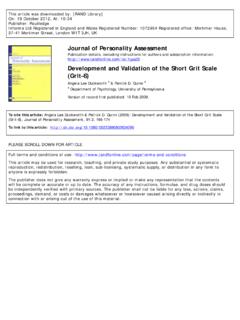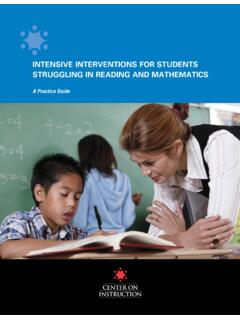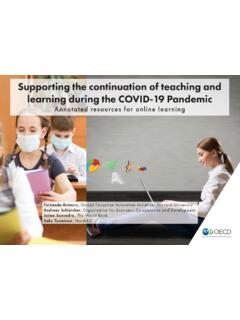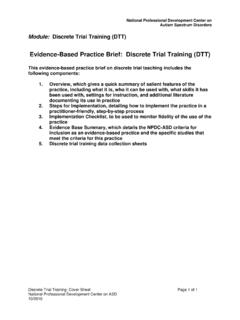Transcription of Supporting the continuation of teaching and learning ...
1 OECD 2020 1 Supporting the continuation of teaching and learning during the COVID-19 PandemicFernando Reimers, Global Education Innovation Initiative, Harvard UniversityAndreas Schleicher, Organisation for Economic Co-operation and Development Jaime Saavedra,The World BankSaku Tuominen, HundrEDSupporting the continuation of teaching and learning during the COVID-19 PandemicAnnotated resources for online learning OECD 2020 2 Supporting the continuation of teaching and learning during the COVID-19 PandemicIntroductionFor educators, the COVID-19 Pandemic is a quintessential adaptive and transformative challenge, one for which there is no pre-confi gured playbook that can guide appropriate responses. Education leaders must swiftly design responses and with specifi c contexts in mind as the pandemic runs its course. This brief discusses the second module of a series which presents the results of a comparative analysis of emerging educational needs and responses as the pandemic unfolds across countries around the world.
2 The overall goal of this series is to facilitate the rapid design process and implementation of adaptive responses to the emerging education challenges, and to protect young people s educational opportunities during and following the fi rst module, published end of March 2020 A framework to guide an education response to the COVID-19 Pandemic is a tool to support education leaders based on a cross-national survey conducted between the 18th and 27th of March 2020. The survey assessed educational needs, priorities, implementation challenges and emerging responses, and was the fi rst of a series of surveys to monitor the evolution of responses to emerging needs in the education second module is a collaborative effort between the Global Education Innovation Initiative at the Harvard Graduate School of Education, the OECD s Directorate of Education and Skills, the World Bank s Education Network and the organisation Hundred.
3 It presents a fi rst set of online educational resources to support the continuity of teaching and learning during the 2019-20 COVID-19 Pandemic with education leaders around the world. The resources were compiled from responses to the same survey used to produce the fi rst module, and additional online sources were included to enhance the list in order to support the continuity of learning for students who have access to the internet and digital devices. Subsequent modules will include a curated catalogue of radio and educational television resources, and a module to guide the implementation of effective education hope these resources help those collaborating across institutions and countries in the important and urgent task of Supporting students opportunity to learn during this challenging crisis shared among Reimers, Global Education Innovation Initiative at the Harvard Graduate School of EducationAndreas Schleicher, OECDJ aime Saavedra, The World BankSaku Tuominen, HundrEDTh e World BankAcknowledgmentsThis module has been created by Fernando M.
4 Reimers in collaboration with Vidur Chopra, Alisa Currimjee, Indah Shafi ra Z. Dini, Farwa Fatima, Ishita Ghai, Crystal Green, Angela Hernandez, Yitong Hu, Rachel Hunkler, Susan Kippels, Hyunjeong Lee, Ana Marcela Lozano, Aditi Nangia, Siury Pulgar, Aneeqa Rana, Tatiana Shevchenko, Sarah Strader, Abdullah Tajwar and Margaret Wang . OECD 2020 3 Supporting the continuation of teaching and learning during the COVID-19 PandemicAn annotated selection of online resources Supporting education continuity during the COV I D -19 Pa n d e mi cAs the COVID-19 Pandemic runs its course, many governments are implementing measures that limit the number of people congregating in public places. Such measures have disrupted the normal functioning of schools and universities. Because the duration of such measures has been extensive and is likely to continue in some countries for a certain time until a vaccine becomes available leaders of public and private education institutions have put in place alternative methods for students and teachers to continue with their lessons when attending school is not possible and are working on methods that will make schools fit for working in a safe environment.
5 Although students with access to digital devices and internet may not be the majority in most countries, Supporting governments in establishing effective forms of online education will free up institutional capacities and resources in order to redirect their focus on delivering alternative learning methods for those students who do not have similar opportunities. This annotated selection of online educational resources intended for students, teachers and parents, aims to support governments and other education leaders as they research and assess different ways to continue educating students during the COVID-19 Pandemic. It can be used by those designing or improving upon a plan for education continuity, by either directly incorporating some of these resources into their plan, or using them as a model to develop their own online educational annotated selection is based on the March 2020 survey responses from 333 participants in 99 countries.
6 We asked a range of stakeholders to identify online educational resources that they had found helpful in Supporting education continuity up to that point. Nineteen former master s students from the Harvard Graduate School of Education, with experience ranging from teachers, teacher coaches, developers of professional development programmes, education administrators and researchers were asked to analyse these resources. They are highly qualified education experts whose professional judgement I trust and value. Furthermore, I greatly appreciate the fact that they gave their time for this global public good team met to discuss the criteria to assess these resources, and then went through them one by one. In addition to classifying each resource by type, language, subject and grade level, the team provided a summary and rated the resources on a scale from one to five, with five being the highest.
7 In addition, when possible, the instructional resources were coded in terms of which competencies they were designed to develop, using a taxonomy from an empirical OECD 2020 4 Supporting the continuation of teaching and learning during the COVID-19 Pandemicliterature review on competencies needed for work and life produced by the National Research Council in the United States . We thought it would be helpful to use this taxonomy in order to code these resources as attention is given to a broad range of skills social and emotional, and cognitive to help students learning outside of school. Therefore, signalling to teachers and parents which resources are designed to serve that goal is useful. The taxonomy is presented below. After careful analysis, we retained about half of the resources which had been collected in the survey, which the reviewing team evaluated as being of high quality.
8 The resources are presented in this document, and in an online searchable database . Every effort was made to code each resource in the various categories. As this was not always possible, the entry for that specific category and for that particular resource was left blank. The resources are grouped into three broad sections, according to their purpose:1. Curriculum Resources: These include lessons, videos, interactive learning modules and any other resources that directly support students in acquiring knowledge and skills. We present 72 resources, which include several repositories of Professional Development Resources: These are resources which can support teachers or parents in Supporting learners, guiding them to content, developing their skills to teach remotely, or more generally augmenting their capacity to support learners now learning more independently and at home, rather than at school.
9 We present 21 professional development Tools: These include tools that can help manage teaching and learning , such as communication tools, learning management systems or other tools that teachers, parents or students can use to create or access educational content. We present 20 professional development each of these categories we present the resources arranged by the language in which they are available (for curriculum and professional development).The following taxonomy is used to classify curriculum and professional development resources (Pellegrino and Hilton, 2012[1]). Reference[1] Pellegrino, and Hilton (eds.) (2012), Education for Life and Work: Developing Transferable Knowledge and Skills in the Twenty-First Century, National Academies Press, Washington, DC. OECD 2020 5 Supporting the continuation of teaching and learning during the COVID-19 PandemicTaxonomy used to classify curriculum and professional development resources (Pellegrino and Hilton 2012)1.
10 Cognitive Skills2. Interpersonal skills3. Intrapersonal Processing and cognitive strategiesC T: Critical ThinkingPS: Problem SolvingA: AnalysisLR: Logical ReasoningI: InterpretationDM: Decision MakingEF: Executive Collaborative group skillsCm: CommunicationCl: CollaborationTW: Team WorkCp: CooperationCo: CoordinationEP: Empathy, Perspective TakingTr: TrustSO: Service OrientationCR: Conflict ResolutionNe: Intellectual OpennessFl: FlexibilityAd: AdaptabilityAr: Artistic and Cultural AppreciationPS: Personal and Social ResponsibilityIC: Intercultural competencyAD: Appreciation for diversityCL: Capacity for lifelong learningII: Intellectual interest and KnowledgeLC: Literacy and communication skillsAL: Active listening skillsKD: Knowledge of the disciplinesEv: Ability to use evidence and assess biases in informa-tionDL: Digital LeadershipLe: LeadershipRe.







